Contents
- Traditional Sports and Games
- Kushti
- Mardaani Khel
- Sports involving animals
- Kids outdoor games
- Vitti Dandu
- Langdi Palati
- Jibli
- Gotya
- Bhoura
- Kids Indoor games
- Kacha - Kavdya
- Bittya
- Vyapar (Business)
- Saripat
- Other Games
- Competitive Sports
- Football
- Gym Culture
- Trekking
- Sports Infrastructure
- Major Dhyanchand Hockey Stadium
- Chh. Rajarshi Shahu Stadium
- Sports Personalities
- Shripati Khanchnale
- Dadu Chougule
- Bhausaheb Nimbalkar
- Siddharth Desai
- Anuja Patil
- Khashaba Dadasaheb Jadhav
- Tejaswini Sawant
- Rahi Sarnobat
- Aniket Jadhav
- Sources
KOLHAPUR
Sports & Games
Last updated on 22 July 2025. Help us improve the information on this page by clicking on suggest edits or writing to us.
Kolhapur, a district steeped in a rich sporting culture, has long been a stronghold of traditional sports, with Kushti (wrestling) standing as a proud centerpiece. Kolhapur is often referred to as the “Pandhari of Wrestling” in India, a title that traces its origins to the foresight and encouragement of Chhatrapati Shahu Maharaj, whose reign marked the golden age of wrestling in the region. It is home to many such other games. Each game has a special age-old local touch attached to it, many of which are connected to royal patronage.
Traditional Sports and Games
Kushti
Kushti, or traditional Indian wrestling, dates back to the 5th century BCE and is thought to be the earliest form of wrestling, known in ancient texts as malla-yuddha (hand-to-hand combat). Its significance is woven deeply into the fabric of Indian culture, as reflected in the Ramayan and the Mahabharat, where references to wrestling illustrate its prominence in both epics and history.
![Wrestlers warm up by doing various exercises such as baithak (squatting)[1]](/media/culture/images/maharashtra/kolhapur/sports-games/wrestlers-warm-up-by-doing-various-exer_ZUjEB4C.jpg)
Kolhapur’s place in this storied tradition cannot be overstated. The region’s prominence in Kushti can be traced to the local King Chattrapati Shahu Maharaj, who recognized the sport's cultural value and provided substantial patronage, facilitating the construction of numerous akharas (wrestling grounds). The progressive ruler was instrumental in building hundreds of Taleems or Akharas (wrestling grounds), as they are known in the north. The city's wrestling schools, known as taleems, played a crucial role in preserving and promoting this ancient sport. The term "taleem," interestingly, is an Urdu word meaning education, reflecting the holistic approach to wrestling training in Kolhapur. The system of training in Kolhapur is meticulously structured. Akharas, locally known as "taleems," are not merely wrestling schools; they embody a holistic educational approach to training. The word "taleem" itself is derived from the Urdu word for education, the term being reflective of what these akharas function as - a kushti educational center.
This foundation of support has kept the wrestling culture alive and flourishing, especially as many families in Kolhapur continue to send their children to akharas from a young age, preserving the sport’s legacy across generations. Kolhapur is renowned worldwide for its kushti (wrestling) tradition. Sharda Ugra, in her Hindustan Times article, comments, “But if there is an indigenous Indian sport awash with both royal and commoner support in a region, it has to be kusti/ kushti or traditional wrestling in Kolhapur.”
Taleems in Kolhapur operate on a selective admission process, considering factors such as the pupil's physical build, strength, capability, diet followed at home, and current weight. The training fees vary based on the age and weight of the pupil. Coaches at these taleems note that Kolhapuri families are enthusiastic about enrolling their boys, recognizing the sport's ability to instill strength and discipline.
The taleem system in Kolhapur is highly systematic. These institutions provide comprehensive services, including cooking meals for the wrestlers, offering resthouses for out-of-town athletes, and conducting training sessions twice daily. Motibag Taleem, one of the most prestigious in Kolhapur, hosts 35-50 wrestlers, with approximately 20 coming from outside Maharashtra, underlining the city's reputation as a wrestling hub.
According to local coaches, the Government of Maharashtra actively supports sports, including wrestling, through funding. They emphasize that Kolhapur offers an ideal environment for learning and practising wrestling, maintaining a “Desi Culture” that is integral to the sport. The city's pleasant weather and lack of extreme climatic conditions make it particularly suitable for outdoor training, attracting wrestlers and weightlifters from across India, especially during summer.
Kushti in Kolhapur is practiced in three categories: freestyle, Greco-Roman, and female wrestling. Competitions are organized for various age groups, including under 14, 17, 19, 23, senior, and veteran categories. Even minor wrestlers can earn money from matches, with the Bhartiya Khel Pradhikaran being a prominent league.
At Motibag Taleem, two types of kushti are practiced. “Chitputi” is performed on a traditional soil akhada, where a match ends when a player is completely thrust on the ground. The other follows a point system and takes place on a 12x12 mat with a central red circle called the “lakshman rekha” or protection area. In this version, matches continue for a fixed duration. The soil akhadas are regularly treated with ghee, milk, and water to maintain their quality. A statue of Hanuman, symbolizing strength, is typically placed at the center of the akhada.
The training regimen for wrestlers is rigorous, including weight training, rope climbing, and running. Their diet is protein-rich, consisting of whole foods such as desi ghee, milk, eggs, chicken, fish, dal, rotis, fruits, vegetables, and multivitamins. Many parents enrol their children to improve their diet and gain weight, with pupils often gaining up to 10 kg within a month of enrollment.
Despite its rich tradition, kushti in Kolhapur faces several challenges. These include: Lack of hostel infrastructure and training equipment, High cost of the program for common people, decrease in enrollment due to the COVID-19 pandemic (from many students to only 30 or 40), Difficulty in securing steady employment after a wrestling career, and students dropping out mid-way through their training due to expenses and career concerns
Mardaani Khel
Another sport that has a link to the royal heritage of Kolhapur is Mardaani Khel. It is the birthplace of many brave mavlas (warriors), a martial art form that has long held Mardaani Khel in high esteem. This traditional martial art form has played a crucial role in instilling values of determination, bravery, and courage - qualities that were emblematic of the mavlas who served under Chhatrapati Shivaji Maharaj.
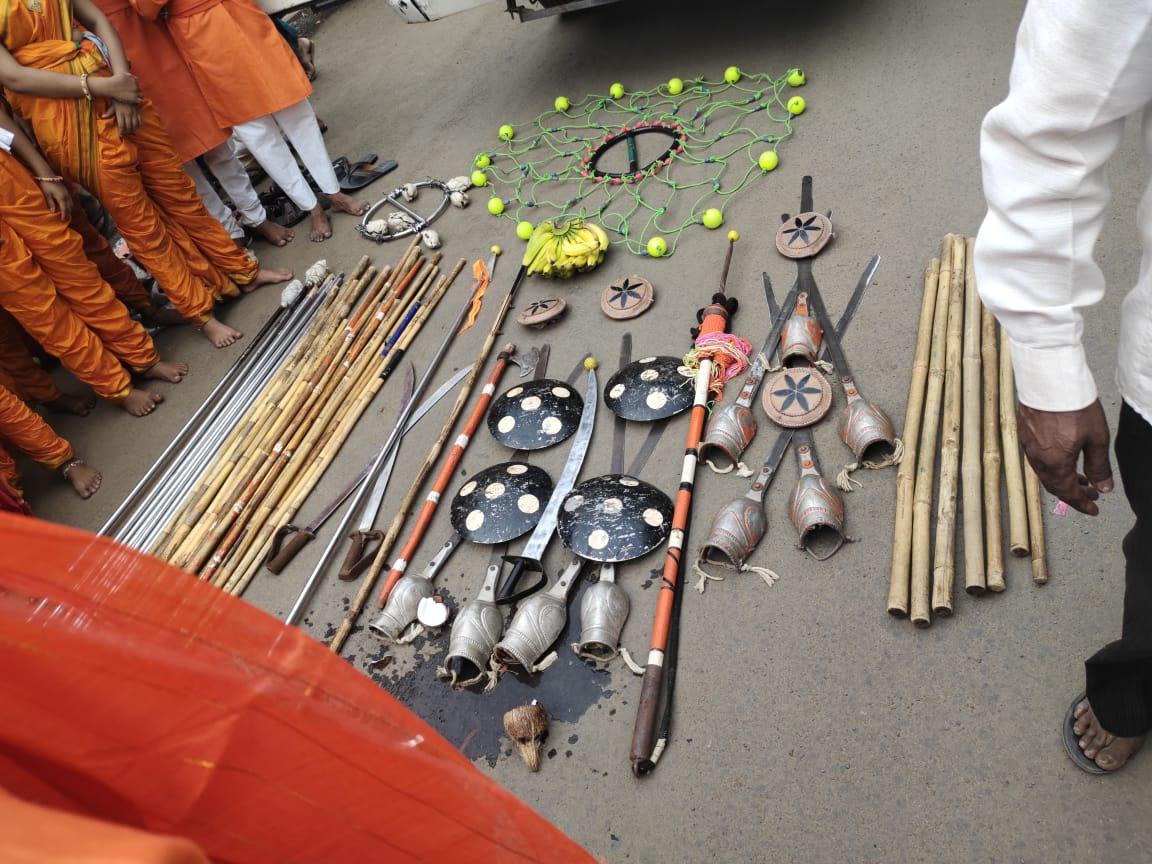
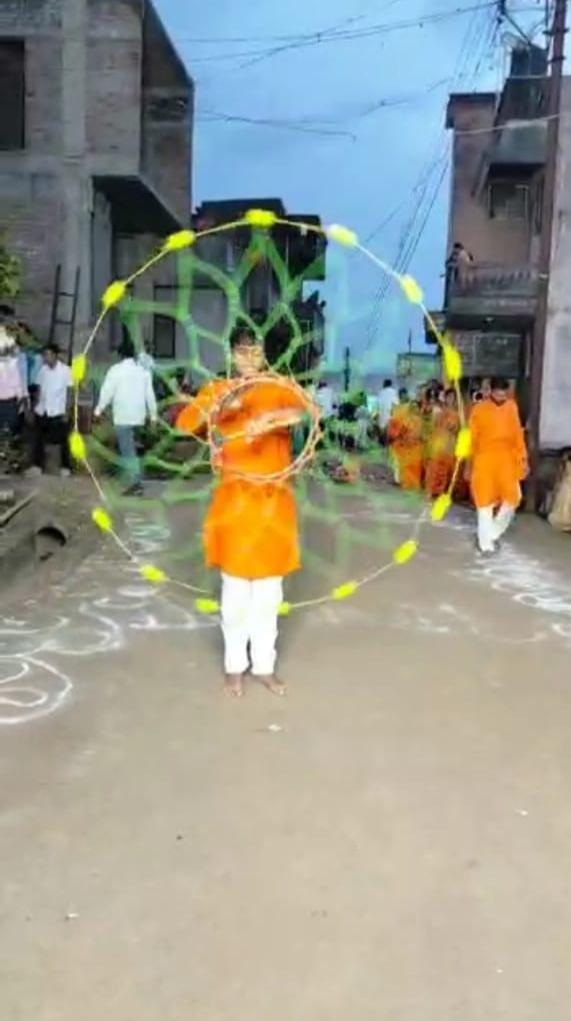
The history of Mardaani Khel is closely intertwined with the legacy of Chhatrapati Shahu Maharaj, who played a pivotal role in reviving this ancient practice alongside wrestling. The sport encompasses various martial disciplines such as Dandpatta, Farigadga, Veeta, Talwar bajji, and Lathi-kathi, all of which trace their roots back to the era of Chhatrapati Shivaji Maharaj. These games served as essential training for combat during those times, preparing warriors for the challenges of battle.
It is said that Chhatrapati Shahu Maharaj's own wrestling guru, Vastaad Balekhan, was well-versed in Mardaani khel. During this period, masters like Dadu Mali, Yesba Hujare, Yashwant Saloke, and Ganpatrao Sasane were renowned for their expertise in these martial arts. Shahu Maharaj actively encouraged the men of Kolhapur to practice Mardaani khel by bringing in various trainers, thus ensuring the continuation of this rich tradition.
Today, Mardaani khel continues to hold significance in Kolhapur district, with practices still taking place in areas like Shivaji Peth and Shukrawar Peth, near the Panchganga ghat. While traditionally reserved for boys and men, the art form has evolved to include girls as well, recognizing its value in self-defense. Children as young as seven years old now participate in these martial arts, with special summer camps being organized to teach Mardaani Khel to the younger generation.
Notable figures like Pandit Anandrao Powar (Anna) arrange camps in Shivaji Peth to impart this knowledge. Akhadas (training centers) such as Jai Shivarai Mardaani Akhada in Unchagaon and Shiv Shambhu Mardaani Akhada in Sarnobatwadi have gained fame for providing free training to children, ensuring that this cultural heritage remains accessible to all.
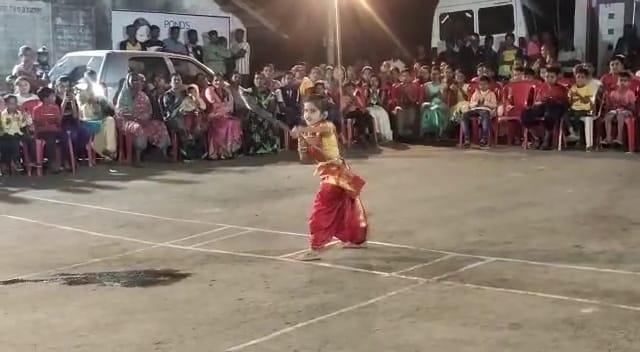
The practice of Mardaani khel not only fosters courage and physical prowess but also plays a vital role in preserving the rich cultural heritage of the region. However, there is a growing recognition that this martial art form should expand beyond the traditional paths and find its way into the school curriculum. Incorporating Mardaani khel into formal education would not only help in its preservation but also ensure that a wider audience benefits from its physical and character-building aspects, thereby continuing the legacy of bravery and determination that has long been associated with Kolhapur and its people.
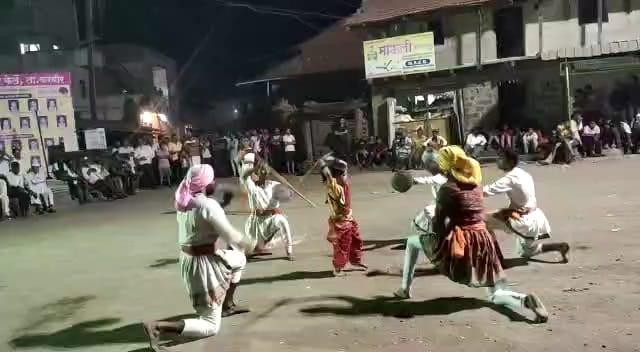
Sports involving animals
Another sport widely played in Kolhapur, associated with farmers and animals, is the race of buffaloes and bulls. These sports are played during Diwali Padwa. This has been observed for many decades. People mostly in rural areas enjoy this game. The animals are decorated with paint, and halgi is played to create a sporty environment.
In buffalo races, the horns of buffalo are cleaned, painted, and kept in good condition before the competition. On the day of the race, the owner sits on the motorcycle in front of Buffalo holding a red cloth in hand and calls out the name of Buffalo. So once the owner calls out the name, the buffalo starts running, and the one that reaches the finish line first is declared the winner.

This is followed by bull races, though the difference is that the bull doesn’t run solely, but the owner sits on the bullock cart and then starts running the cart.
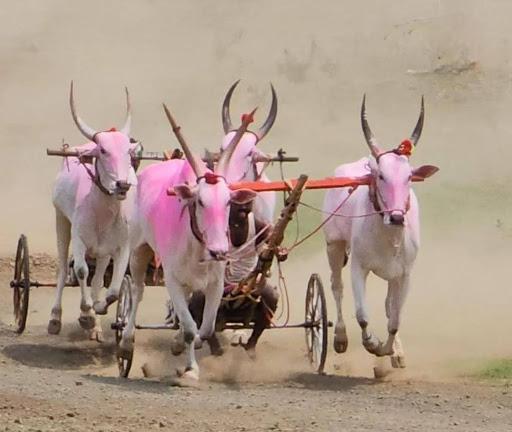
Kids outdoor games
Vitti Dandu
Vitti Dandu, also known as Gilli Danda or Kitti Pul, is a game that originated in the Indian subcontinent over 2000 years ago. Gilli Danda is played using two pieces of wood, one long stick (danda) and a round piece of wood (gilli). The game is played by keeping the gilli on a stone, half-suspended in the air. One player hits the gilli with the danda and launches it into the air. The player must try to hit the gilli as far away as possible. A player from the opposite team must retrieve the gilli. In the meantime, the player who hit the gilli must run to a designated spot and return before the gilli is retrieved. If the gilli is caught before the player returns, then the opposing team wins. Gilli danda can be played with any number of players and is most commonly played in rural areas of India.
Langdi Palati
A hopping game where one player hops on one leg, trying to tag others.
Jibli
A game similar to marbles, but played with seeds or small stones.
Gotya
Another variation of marbles was played with small round stones or glass balls. There were games which were prohibited by parents, like gotya and cards (patte). Especially, girls in some households were not allowed to play these games, as the different versions of these games included gambling. Thus, society, in those times, thought that playing these games was not a good indication of their character. It was often said, “hatat goti, vidya khoti.” (meaning if you play with gotis, your education is of no use).
Bhoura
A game played with spinning tops.
Kids Indoor games
Kacha - Kavdya
A game played with sea shells or tamarind seeds, involving strategy and counting.
Bittya
A game played with buttons, where players try to flip their buttons onto their opponent's buttons.
Vyapar (Business)
A Marathi version of the game Monopoly, involving buying and selling properties.
Saripat
Saripat, popularly referred to as Chaupar, is an indoor game that originated in India. The game is played on a cloth piece shaped like a cross. It is quite similar to Ludo and requires four players. In this game, cowry shells are used as dice, and each player must make an entire round of the board to win. In Kolhapur, seeds of different fruits are also used as pawns.
Other Games
Collecting empty cigarette packets, matchboxes, and challenging each other to collect more, girls played more like bhaula bhauli lagna (marriage was falsely created between male and female dolls), jevan paani, in which a small miniature kitchen set was used.
Many games seen today have been adopted from the traditional games like ludo, snakes & ladder, and business, which are now played on phones and were then played only on boards. Back then, the games were more enjoyable than today, and thus, the previous generations were more fit than today’s.
Competitive Sports
Football
Rajarshi Shahu Maharaj, a true patron of sports, had a deep fascination for wrestling and went to great lengths to create facilities that would nurture the sport in Kolhapur. His successors, Rajaram Maharaj and Prince Shivaji Maharaj, continued to build upon this rich sporting legacy, each leaving an indelible mark on the city's athletic landscape.
It was during a trip to London in 1914 that Prince Shivaji Maharaj first encountered the game of football. Captivated by the infectious enthusiasm of the English fans, he returned home determined to introduce this new sport to the people of Kolhapur. Along with his friend Narayan Singh, the prince began playing football, much to the initial bewilderment of the locals. However, it didn't take long for the Kolhapurkars to get swept up in the excitement of this novel game.
After Prince Shivaji Maharaj's untimely demise, Rajaram Maharaj took up the mantle of establishing football in Kolhapur in 1920. He founded the Jamdar Football Club, a pioneering move at a time when the FIFA World Cup was still a distant dream. Despite facing numerous challenges, football gradually gained traction in the city, with over 25 teams springing up between 1925 and 1930.
In 1940, Rajaram Maharaj took his commitment to sports a step further by establishing the Kolhapur Sports Association (KSA), an organization dedicated to nurturing talent across various disciplines. He served as the chief patron for five years, laying the foundation for future generations to build upon.
When Chhatrapati Shahaji Maharaj, Shahu Maharaj's grandson, took over the reins of the KSA, he ushered in a new era of growth for football in Kolhapur. Under his leadership, the game reached even the remotest corners of the district, captivating audiences far and wide.
Shahaji Maharaj's passion for sports extended beyond football, encompassing disciplines like cricket, tennis, and gymnastics. From 1947 to 1983, he worked tirelessly to create a sporting culture in Kolhapur, spearheading the formation of teams such as Jamdar Club, Rajwada Sangh, Chhatrapati Football Sangh, Balveer Sangh, Shivaji Tarun Mandal, Devas Yuvraj Kayab, and Sarjerao Club.
Under his guidance, Kolhapur witnessed the birth of several prestigious tournaments, including the Shiv Jayanti Club, Belgaum Cup, Dasra Cup, Anwar Cup, and Sangli Sansthan Cup. These events not only showcased the city's talent but also served as a platform for aspiring athletes to showcase their skills.
The likes of Yandev Sathe, Ram Kamble, Pracharya Milka Singh, Gopalrao Uparkar, Hindurao, Salokhe, and Dinkarrao Shinde carried forward the torch lit by Chhatrapati Shahaji Maharaj, etching their names in the annals of Kolhapur's sporting history. Legends like Nizam Momin, Papa Pardeshi, Bhimrao Dalvi, and Dagdu Master further cemented the city's reputation as a hotbed of football talent.
As the years passed, Kolhapur's government institutions, training teams, and prominent businessmen joined hands to promote sports and support its athletes. This collective effort led to the establishment of organizations such as the S.T. Mahamandal Football Sangh, Kolhapur Manapa Sangh, Kolhapur Police Sangh, Dilbahar Talim Sangh, Shahupuri Football Sangh, Kandoba Talim Sangh, and Phulewadi Krida Mandal, many of which continue to thrive today.
The girls of Kolhapur have also embraced the spirit of football, with Mrs. Madhurima Raje serving as the Vice President of the Women's Division of the Western India Football Association (WIFA), a testament to the city's commitment to gender equality in sports.
In 2013, Kolhapur's love for football reached new heights when an international match between India and the Netherlands was held at the Shahu Stadium, drawing an astounding crowd of twenty thousand fans.
Gym Culture
Over the years, gyms have gained immense popularity in Kolhapur district. Initially, these facilities primarily catered to bodybuilders, but now they attract a wide range of people who visit regularly to maintain their health and fitness. The enthusiasm for gym culture is particularly noticeable among the youth of the Kolhapur district. This trend is not limited to Kolhapur city alone; even small villages in the district now boast their own gym facilities.
Compared to earlier times, there has been a significant increase in the number of gyms across the district. These modern facilities offer a variety of exercise options and workout programs to suit different needs and preferences. Many gyms now employ professional trainers who guide members on proper exercise techniques and routines. This ensures that people can work out safely and effectively, maximizing the benefits of their gym sessions. Social media has played a crucial role in spreading awareness about fitness among Kolhapur's residents, especially the younger generation. This exposure has helped them understand the importance of staying active and maintaining a healthy body.
However, the gym culture in Kolhapur is not without its drawbacks. There have been concerning reports of male bodybuilders losing their lives due to the excessive use of steroids, often stemming from an obsession with body image. This highlights the need for proper education and guidance in the fitness community to promote healthy and sustainable practices.
Despite these challenges, the growing gym culture in the Kolhapur district represents a positive shift towards health and fitness consciousness among its residents. With proper guidance and awareness, this trend has the potential to significantly improve the overall health of the community.
Trekking
The youth of Kolhapur have developed a strong affinity for trekking and camping. The district's location in the Western Ghats provides an ideal setting for nature enthusiasts to organize various treks and camps. However, what sets Kolhapur's trek culture apart is the emphasis on preserving and celebrating local history and culture alongside the enjoyment of nature.
One of the most significant and popular treks organized in the region is the "Panhala to Pavankhind Shourya Mohim" (Panhala to Pavankhind Bravery Campaign). This trek takes place annually in July and has become a tradition over the years. Various groups, including friends, local organizations (mandals), wrestling schools (talims), and tour companies, come together to arrange this event.
The primary objective of this trek is to instill a sense of Maratha pride among the younger generation and educate them about the historic Battle of Pavankhind. This battle, which took place in 1660, is an important event in Maratha history, showcasing the bravery and strategic brilliance of Maratha warriors led by Baji Prabhu Deshpande.
The trek begins at Panhala Fort and concludes at Pavankhind, following the route taken by Chhatrapati Shivaji Maharaj and his forces during their escape from the siege of Panhala. While the exact distance is not mentioned in the provided information, it's known to be a challenging route through the rugged terrain of the Western Ghats.
This event has gained immense popularity over the years, attracting thousands of young participants annually. The trek not only provides a physical challenge but also serves as an immersive history lesson, allowing participants to walk in the footsteps of their ancestors and gain a deeper appreciation for their cultural heritage.
Sports Infrastructure
Major Dhyanchand Hockey Stadium
The Major Dhyanchand Hockey Stadium in Kolhapur is named after the legendary Indian hockey player Major Dhyan Chand, who was one of the greatest hockey players in history. This stadium is a significant place for hockey in Kolhapur. The stadium has hosted numerous local, state, and national-level hockey tournaments. The stadium also hosts various events, including training camps, coaching, inter-school competitions, and cultural programs. The Major Dhyanchand Hockey Stadium has played an important role in promoting sports culture in Kolhapur and encouraging youth to participate in sports. The Major Dhyanchand Hockey Stadium in Kolhapur was built with the efforts of local sports-loving people, the government, and sports authorities. Notable Hockey Players from Kolhapur include Dhanraj Pillay, Vikram Pillay, and Vikas Pillay.
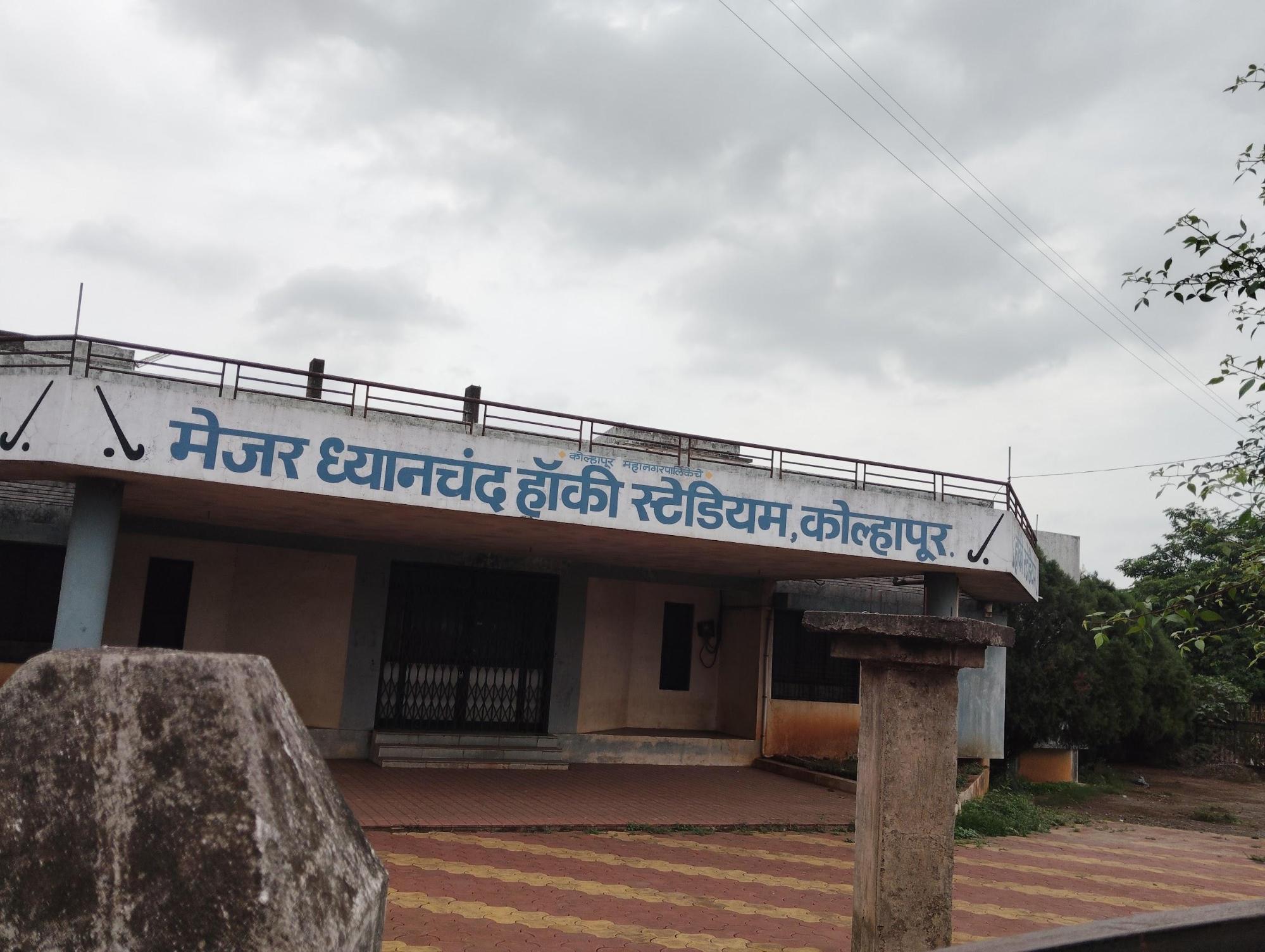
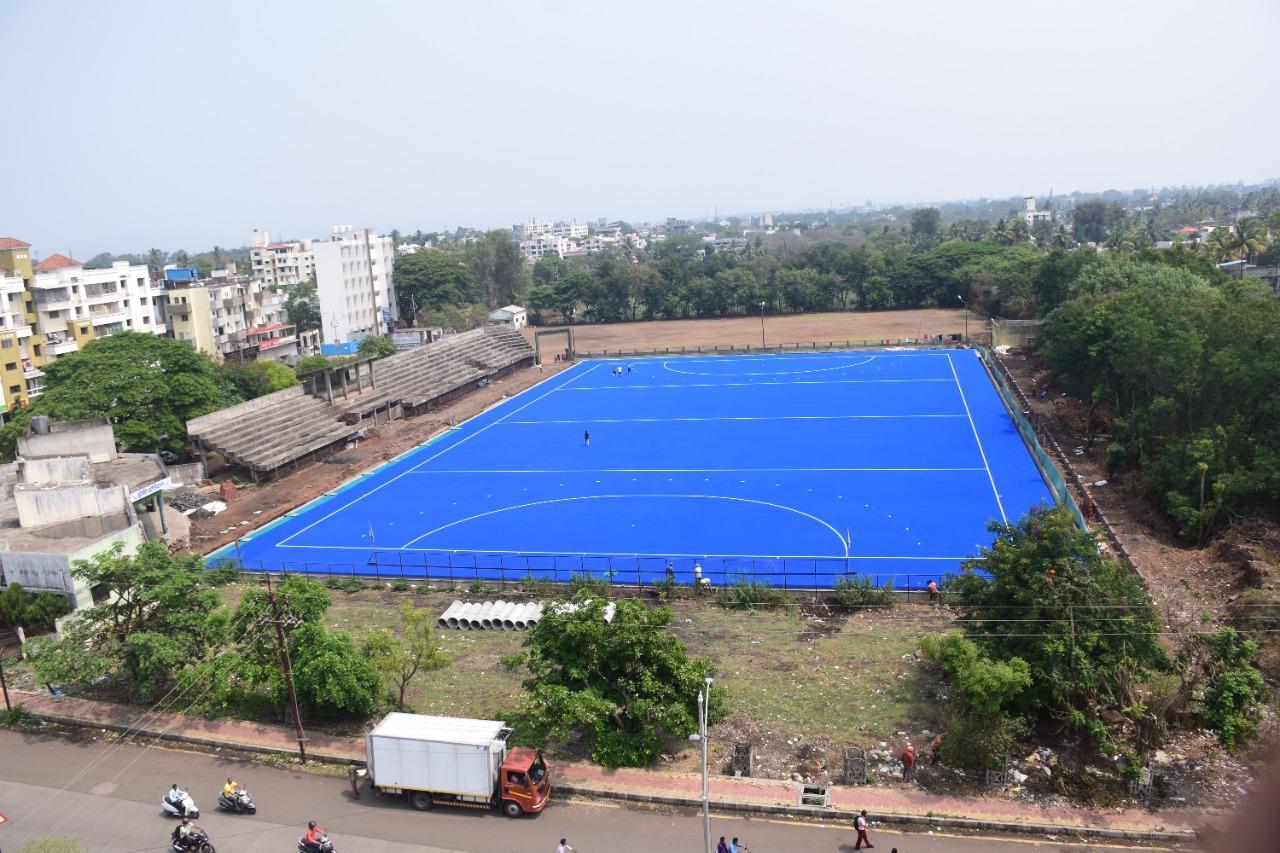
Chh. Rajarshi Shahu Stadium
Just as Rajarshri Shahu Maharaj took wrestling to the national level, in the same way, Chhatrapati Rajaram Maharaj built the foundation of football.
Major Football tournaments in Kolhapur are played in Shahu Stadium. The 'Football Mahasangram' league championship is held in the stadium. There are about 10,000 people.
Thousands of people gather at the Shahu stadium to watch the performance of their beloved clubs. This crowd created a glorious history. The people contribute to the game of football by cheering for their teams, and this has continued in this district for a long time.
“Even though football is not the native game, both men and women enjoy this sport from the bottom of their hearts with sentiments attached to their respective teams. It is the devotion of the players and people of Kolhapur that has made Kolhapur district famous for Football leagues,” said one of the players. It is often said that, ‘क्रिकेट वेड्या जगात फुटबॉल वेडे कोल्हापूर.’ (In a world crazy for cricket, Kolhapur is crazy for football)
The stadium is located on Subhash Road. With the changing times, today, teenagers in Kolhapur have made football their favourite sport.
The Kolhapur Sports Association (KSA), established back in the 1930s along with the Kolhapur United Football Association (KUFA), does a great job by encouraging youth towards football and by organising local, national, and international-level matches.
Major Football clubs are Shivaji Tarun Mandal, Sandhyamath Tarun Mandal, Balgopal Talim Mandal, Phulewadi Football Club, Patakdil Talim Mandal, Dilbahar Talim Mandal, and Shivneri Sports.
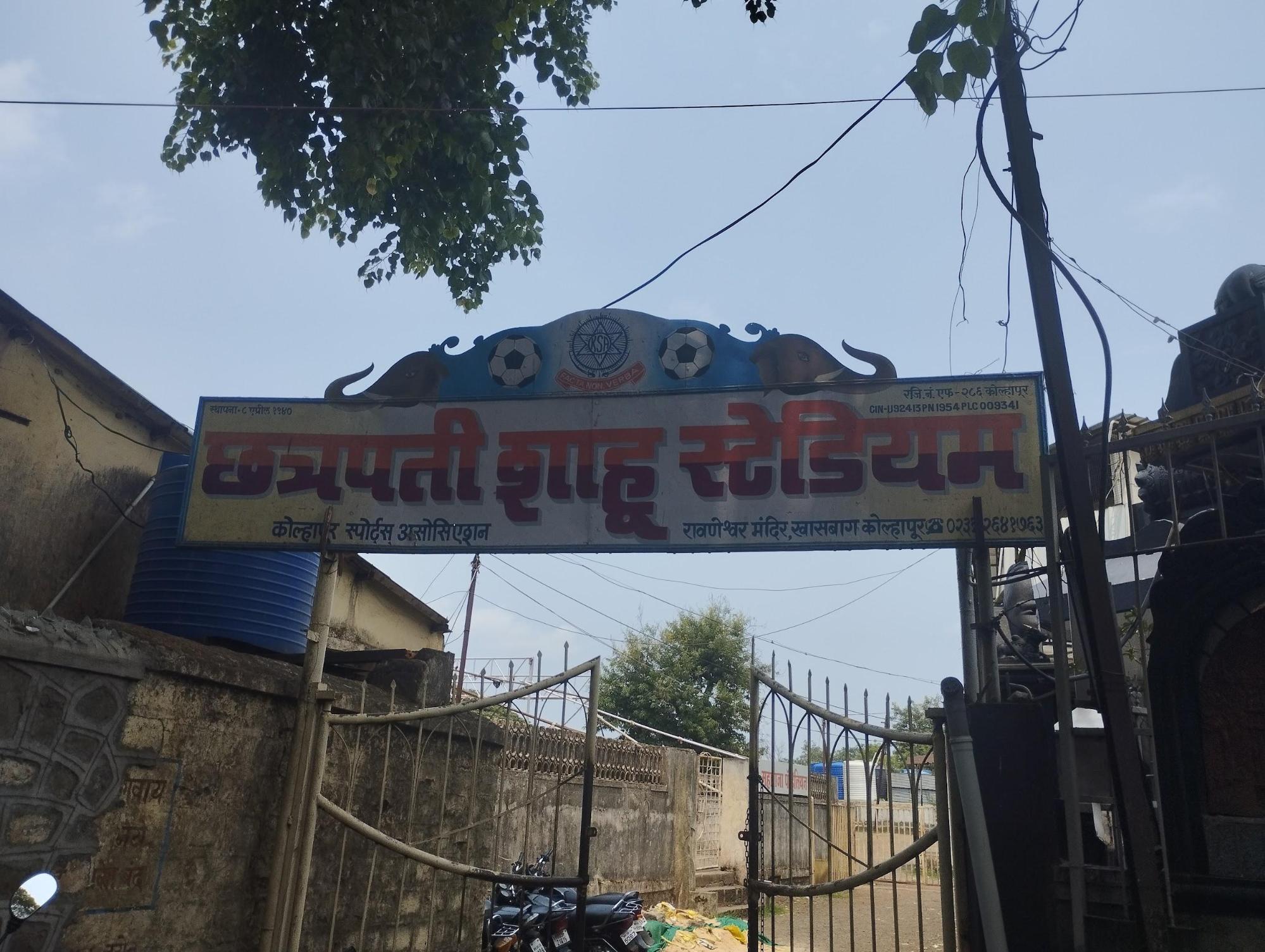
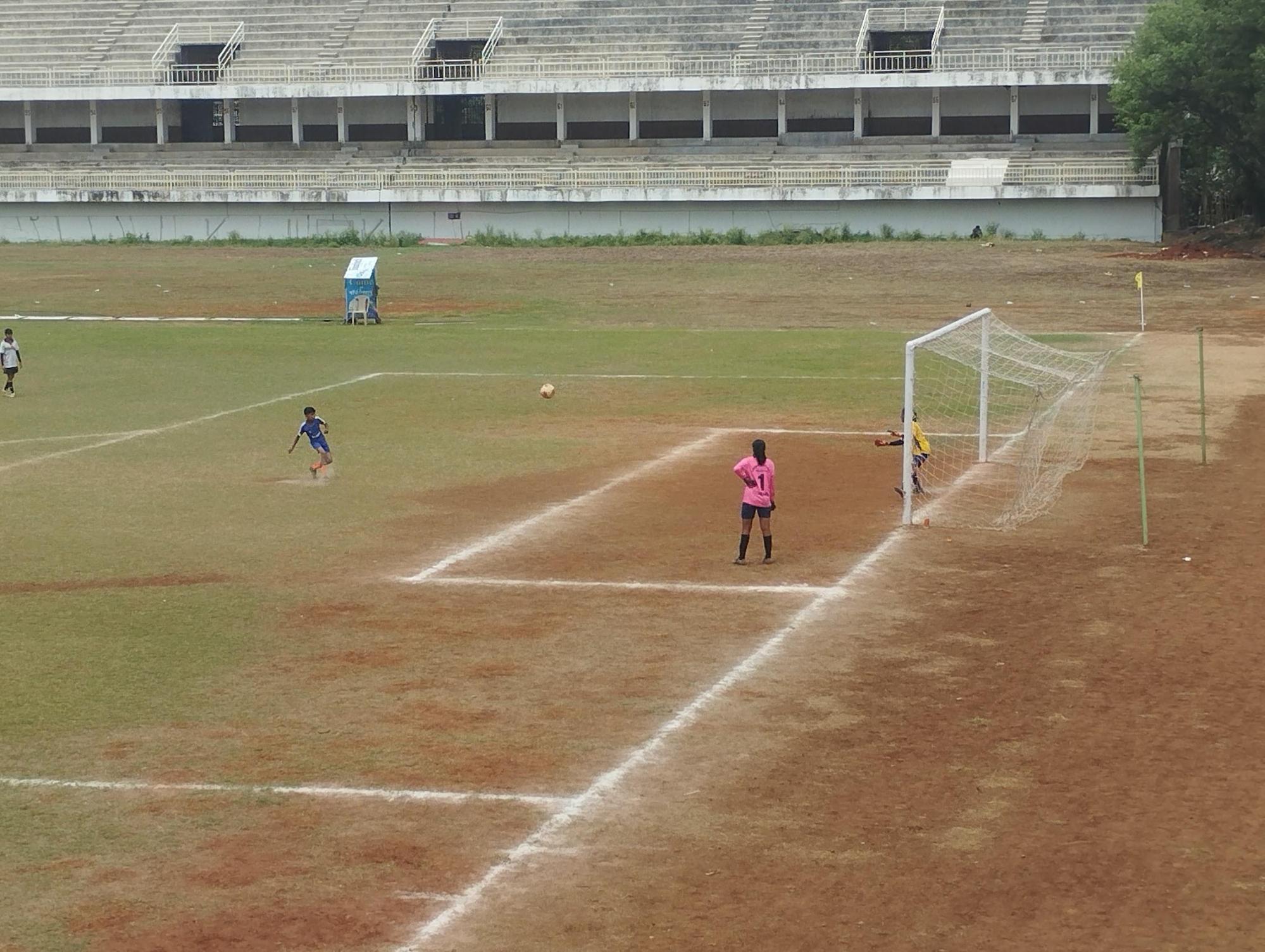
Sports Personalities
Shripati Khanchnale
![Shripati Khanchnale[2]](/media/culture/images/maharashtra/kolhapur/sports-games/shripati-khanchnale2-6e25082c.jpg)
In 1959, he defeated Punjab Kesari Banta Singh and won the 'Hind Kesari' title for the first time. The same year, he won the Maharashtra Kesari award defeating Anand Shirala each in Karad of Satara district.
Dadu Chougule
![Dadu Chougule[3]](/media/culture/images/maharashtra/kolhapur/sports-games/dadu-chougule3-1de686b6.jpg)
Dadu Chougule won several prestigious titles, such as Maharashtra Kesari, Rustam Hind Kesari, and Mahan Bharat Kesari in the 1970s. He won a silver medal in the Commonwealth Games in New Zealand in 1974. He was a recipient of the prestigious Dhyan Chand Award for lifetime achievement in sports.
Bhausaheb Nimbalkar
![Bhausaheb Nimbalkar[4]](/media/culture/images/maharashtra/kolhapur/sports-games/bhausaheb-nimbalkar4-ee9a3d06.jpg)
Known for scoring 443 not out for Maharashtra against Kathiawar in a Ranji Trophy match in 1948-1949.
Siddharth Desai
![Siddharth Desai[5]](/media/culture/images/maharashtra/kolhapur/sports-games/siddharth-desai5-e294e4f4.jpg)
Siddharth Desai, an Indian Kabaddi player, who currently represents the VIVO Pro Kabaddi Franchise Haryana Steelers.
Anuja Patil
![Anuja Patil[6]](/media/culture/images/maharashtra/kolhapur/sports-games/anuja-patil6-01f7dbb9.jpg)
Anuja Patil made her international T20 debut for India in 2012. She also played for Maharashtra State.
Khashaba Dadasaheb Jadhav
He made history by winning India's first individual Olympic medal in wrestling at the 1952 Helsinki Olympics. KD Jadhav not only placed Indian wrestling on the global stage but also became independent India's first sporting hero.
Tejaswini Sawant
In 2006, she was chosen to represent India at the Commonwealth Games, surpassing Asian Games gold medallist Anjali Ved Pathak Bhagwat and world record holder Suma Shirur. At the Commonwealth Games in Melbourne that year, she secured gold medals in both the Women's 10m Air Rifle singles and the Women's 10m Air Rifle Pairs events, partnering with Avneet Kaur Sidhu. In 2009, she earned a bronze medal in the 50-metre rifle three positions at the ISSF World Cup in Munich. On August 8, 2010, she became the World Champion in the 50m Rifle Prone event in Munich, Germany, becoming the first Indian woman shooter to win a gold medal at the World Championships, with a world-record-equalling score in the 50m Rifle Prone event.
During the 2010 Commonwealth Games in Delhi, she won silver in the Women's 50 m Rifle Prone singles and bronze in the Women's 50m Rifle Prone pairs, alongside Meena Kumari. She also secured a silver medal in the Women's 50m Rifle 3 Positions event, teaming up with Lajjakumari Goswami.
At the 2018 Commonwealth Games, on April 12, she won a silver medal in the Women's 50m Rifle Prone Finals with a cumulative score of 618.9. The following day, on April 13, she claimed gold in the Women's 50m Rifle 3 Position Finals, setting a Games Record with a total of 457.9 points.
Rahi Sarnobat
A talented female shooter, she specializes in the 25m pistol event. She made history by becoming the first Indian woman to win a gold medal in shooting at the Asian Games, clinching the top spot in the women's 25m pistol event at the 2018 Jakarta Palembang Asian Games. Sarnobat's achievements extend beyond this milestone, as she has also won multiple gold medals at the Commonwealth Games. In the 2010 Commonwealth Games held in New Delhi, she secured two gold medals, one in the 25m pistol pair event alongside Anisa Sayyed, and another in the individual 25m pistol event. Her success story began at the 2008 Youth Commonwealth Games in Pune, where she won her first gold medal in the 25m pistol event. Sarnobat's remarkable performances have cemented her place as one of India's most accomplished female shooters, inspiring many aspiring athletes to follow in her footsteps.
Aniket Jadhav
Aniket Jadhav began his career with Balewadi Prabodhini, Pune, under the guidance of coach Jaydeep Angirval. He was part of the AIFF Elite Academy batch that prepared for the 2017 FIFA U-17 World Cup, which was hosted in India.
Jadhav made his professional debut for the Indian Arrows in their first match of the season against Chennai City. He started the game and scored a brace, leading the team to a 3–0 victory. This impressive performance marked the beginning of Jadhav's professional career.
In March 2022, Jadhav's dedication and skills were recognized when he received a call-up to the Indian national squad by coach Igor Štimac. He was selected to represent India in two friendly matches against Bahrain and Belarus, further showcasing his potential on the international stage.
Sources
Jain, S., & Joshi, S. 2021, August 14. In Kolhapur: Wrestlers’ diets, weighty problems. People’s Archive of Rural India.https://beta.ruralindiaonline.org/article/in…
Karelia, G. 2019, May 20. Kolhapur’s century-old tryst with wrestling gave India its 1st individual Olympic medal. The Better India.https://thebetterindia.com/182728/kolhapur-w…
Ugra, S. 2024, March 1. In Kolhapur’s famous mud pits, the art of wrestling continues to enthral. Hindustan Times.https://www.hindustantimes.com/india-news/in…
Last updated on 22 July 2025. Help us improve the information on this page by clicking on suggest edits or writing to us.